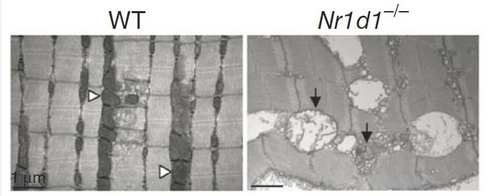A drug that improves endurance
July 17, 2013

Electron microscopy analysis of muscle from Nr1d1−/− mice (with lower Rev-erbα) and WT (wild type, or normal) mice. Black arrows: swollen, less dense mitochondria; white arrowheads, normal mitochondria. Scale bar, 1 μm. (Credit: Estelle Woldt et al./Nature Medicine)
A drug candidate designed by scientists from the Florida campus of The Scripps Research Institute (TSRI) significantly increases exercise endurance in animal models, an international group of scientists has shown.
These findings could lead to new approaches to helping people with conditions that acutely limit exercise tolerance, such as obesity, chronic obstructive pulmonary disease (COPD), and congestive heart failure, as well as the decline of muscle capacity associated with aging.
The drug candidate, SR9009, is one of a pair of compounds developed in the laboratory of TSRI Professor Thomas Burris and described in a March 2012 issue of the journal Nature as reducing obesity in animal models.
Increased metabolic activity
The compounds affect the core biological clock, which synchronizes the rhythm of the body’s activity with the 24-hour cycle of day and night. The compounds work by binding to one of the body’s natural molecules called Rev-erbα, which influences lipid and glucose metabolism in the liver, the production of fat-storing cells, and the response of macrophages (cells that remove dying or dead cells) during inflammation.
In the new study, a team led by scientists at the Institut Pasteur de Lille in France demonstrated that mice lacking Rev-erbα had decreased skeletal muscle metabolic activity and running capacity. Burris’ group showed that activation of Rev-erbα with SR9009 led to increased metabolic activity in skeletal muscle in both culture and in mice. The treated mice had a 50 percent increase in running capacity, measured by both time and distance.
“The animals actually get muscles like an athlete who has been training,” said Burris. “The pattern of gene expression after treatment with SR9009 is that of an oxidative-type muscle — again, just like an athlete.”
The authors of the new study suggest that Rev-erbα affects muscle cells by promoting both the creation of new mitochondria (often referred to as the “power plants” of the cell) and the clearance of those mitochondria that are defective.
Scientists at the Institut Pasteur de Lille, TSRI, Université Lille Nord de France, and Maastricht University Medical Center were involved.
The study was supported by a Marie Curie International Reintegration Grant, the European Commission consortium Eurhythdia, Région Nord Pas-de-Calais/FEDER, a CPER “starting grant,” the European Genomic Institute for Diabetes, an unrestricted ITMO/Astra Zeneca grant, a joint Société Francophone du Diabète MSD research fellowship, Research Grant from the European Foundation for the Study of Diabetes, National Institutes of Health grant, and a VICI Research grant for innovative research from the Netherlands Organization for Scientific Research.